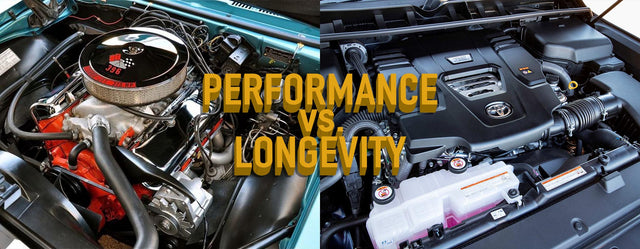Why does a Toyota Corolla engine last several hundred thousand miles (assuming it is maintained) while a Top Fuel dragster requires a rebuilt engine after every run?
An engine is an incredibly synchronized and efficient machine. It must repeat its movements or "events" billions of times in its lifetime with minimal friction and wear. This is where lubrication and oil are critical—they reduce friction and help manage heat buildup, both of which are essential for longevity.
However, when you prioritize performance, the demands on the engine change significantly. Maintenance becomes more frequent, and actual part replacements—even entire systems—are often necessary. But why is this the case?
A seemingly logical question might be: “If an engine produces more power, doesn’t that mean it’s more efficient? And if it’s more efficient, shouldn’t it last longer?”
The reality is that there are many factors to balance in engine design. When comparing, say, a Toyota Corolla engine to a performance engine, their objectives are entirely different. The Corolla’s priorities are centered around longevity, reliability, and fuel efficiency. Performance is only considered to the extent needed for practical, everyday driving.
Why is this distinction important?
When considering performance equipment in any build, you must ask yourself if you are willing to spend the extra time and effort maintaining your car.
It’s worth admitting that simply increasing displacement (engine size) can provide more power without necessarily turning the engine into a "performance engine." Or, if you take your existing engine and start adding turbochargers, superchargers, high-performance fuel systems, or headers, you're fundamentally altering the performance characteristics of the engine. This often results in increased temperatures and pressures, which impact both performance and durability.
Everything in engine building or engine selection is a choice that you have to balance. More performance = more maintenance. New larger engine = more fine tuning as you drive because all the additions that have to be made to use a non-native powertrain.
In selecting your engine you need to know that there are key differences between a "street motor" and a race motor. The conversation gets even more complicated with the innovation of newer technologies in commercial engines, which can rival the power of older performance engines.
Take again into consideration the Toyota Corolla as an example. There are more Corollas on the road than any other vehicle, and if it were its own company, it would rank in the top five automakers globally. Why? Corrola is not selling performance, they are selling reliability. Basically they are saying “buy this and never think about your car”... Meanwhile, Toyota has quietly advanced engine technology for years with the launch of the new Land Cruiser. By integrating turbochargers with higher-compression four-cylinder engines and pairing them with hybrid electric motors, Toyota achieves impressive output. The turbocharged four-cylinder hybrid in the Land Cruiser delivers 326 horsepower (at 6,000 RPM).
For comparison, a GM LS1 engine—a benchmark in performance engines—produces 350 horsepower (at 5,600 RPM). The Toyota engine is almost half the size of the LS and putting out almost the same horsepower. But RPM matters... Power-ban matters.
Why RPM Matters
The RPM (revolutions per minute) at which an engine produces power is critical. Performance engines are built to operate at higher RPMs, but only for short bursts. The heat and pressure generated at those levels cause rapid wear and can distort engine components due to thermal expansion and contraction.
Street engines, on the other hand, operate at lower RPMs most of the time. Their components are designed for durability, with lower compression ratios that reduce stress on the engine. Toyota’s turbocharged engines, for example, achieve high efficiency by increasing cylinder pressure and optimizing air-fuel mixtures. However, this comes with trade-offs:
Fuel Requirements: High-octane gasoline is mandatory.
Maintenance Needs: Regular oil changes, fuel system cleaners, and precise timing adjustments are essential to ensure longevity.
These modern engines use cutting-edge engineering to maximize power output, but they demand meticulous care and are less forgiving than traditional low-compression engines. While the LS series have a greater variety of tuning capability and can be seen as more diverse in their uses.
Building with Modern Technologies
In the world of project cars and engine builds, the possibilities today are just incredible. Advanced materials, stronger alloys, and higher-quality components have transformed what’s achievable. For example, modern forged pistons and rods can withstand significantly higher pressures and temperatures than their cast counterparts, enabling higher performance without sacrificing reliability.
There’s no reason to build a completely stock motor today when modern parts and technologies can deliver both improved power and reliability. Engine building has become an art form, requiring both technical expertise and craftsmanship. When you hire a skilled engine builder, you’re not just paying for parts—you’re investing in their years of experience and knowledge.
Check out these comparisons:
Horsepower and Torque:
The LS1 slightly edges out the Toyota powertrain in peak horsepower (350 HP vs. 326 HP). However, Toyota’s hybrid system generates significantly more torque (~465 lb-ft) compared to the LS1’s ~365 lb-ft, giving it superior low-end responsiveness and acceleration, especially in urban settings or stop-and-go traffic.
Displacement:
The LS1 achieves its power through sheer displacement (5.7L vs. Toyota's 2.4L). Toyota, however, uses a turbocharger and hybrid-electric assistance to deliver comparable power from a smaller, more efficient package.
Efficiency:
Toyota’s turbocharged hybrid is designed to maximize fuel efficiency while maintaining performance. Its hybrid system recaptures energy during braking and supplements power demands, making it significantly more efficient than the LS1, which relies entirely on gasoline combustion.
Performance Character:
The LS1 is a naturally aspirated engine with a strong mid-range and high-end power curve, better suited for high-performance and race applications. In contrast, the Toyota powertrain balances performance with daily drivability, offering immediate low-end torque and smoother power transitions.
Modern Engineering vs. Traditional Power:
Toyota's hybrid turbocharged engine reflects advancements in engine technology, blending electric and forced-induction power for performance and efficiency. The LS1, on the other hand, represents a classic high-displacement V8 approach, known for reliability and ease of modification.
The Toyota turbocharged hybrid powertrain and the GM LS1 engine cater to different needs:
The Toyota powertrain excels in efficiency, low-end torque, and modern design, ideal for urban drivers and those who value cutting-edge engineering. The LS1 engine offers raw power, a wider tuning potential, and a visceral driving experience, making it perfect for performance enthusiasts and racers. While both deliver similar horsepower, the hybrid’s torque advantage and efficiency highlight the evolution of powertrain technology.
Just to compare two totally different engines and the technological innovation of today I made a graph to compare the industry standard GM- LS1 and the Toyota Turbo Charged 4 Cylinder Hybrid.


